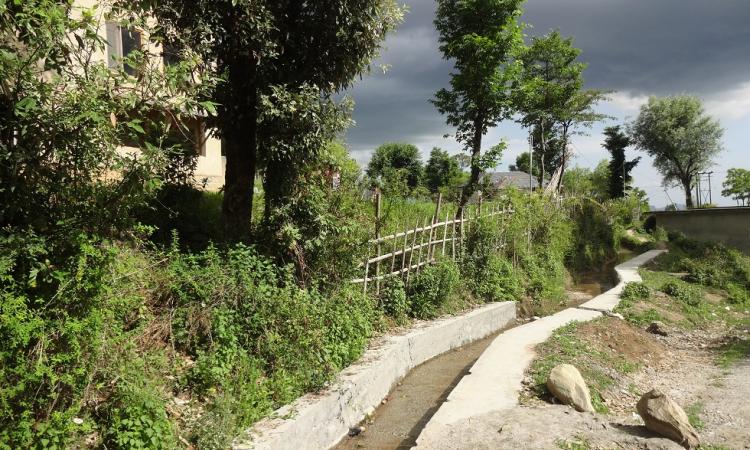
Ranjit Singh is elated that someone has come to his village enquiring about his work. He says not many people recognise the worth of traditional occupations like his. “This is especially true of government officials and policy makers who feel everything old is useless”, he points out.
Ranjit is the kohli of Mjately village in Kangra district of Himachal Pradesh.
His title may not have legal and executive powers but it offers substantial social influence, especially in summer. Kohlis are the traditional water masters of Himachal, supervising allocation for irrigation of fields and settling disputes among farmers.
What does a Kohli do?
A kohli is so designated because he is the master of a ‘kuhl’, the channel which carries glacial melt through gravity from nearby streams to the fields. The title is passed on through generations in a family. “My grandfather was a kohli and I took over the role after my father was unable to perform the functions due to ill health 12 years ago. Though there’s no substantial benefit of this position, you do get the respect”, says Ranjit Singh.
This respect was ingrained in earlier societies because a kohli was believed to possess miraculous powers as the point man of deities who provide water. For all the voluntary work he does, the kohli is paid in kind. Each farmer offers a small share of the produce as a form of gratitude. But over a period of time both the kuhl and the kohli have stopped being important.
The kuhls story
Kuhls and kohlis are a part of a centuries-old heritage which was unique as it had common people mingling with kings, feasts which lasted for weeks, curses which turned into miracles and superstition juxtaposed with geological science. Historically, kuhls were built through public donations or grants from kings, queens and British rulers.
Kangra valley in Himachal Pradesh has the most extensive network of these engineering marvels. Approximately 715 major and over 2500 minor kuhls irrigate more than 30,000 hectares in the valley (Baker 1996). Pre-colonial Katoch rulers of Kangra sponsored the construction of 19 of the longest and largest kuhl irrigation systems in the region, which is why most of these kuhls are named after them. 'Kirpal Chand Kuhl', which runs through Palampur, was named after Kirpal Chand, brother of Raja Bhim Chand who ruled erstwhile Kangra in the 1690s. ‘Saheb ki Kuhl’, reaching Tika Baaghni near Dharamsala, is named so because a British officer commissioned it to irrigate his 320 hectare tea garden in 1944.
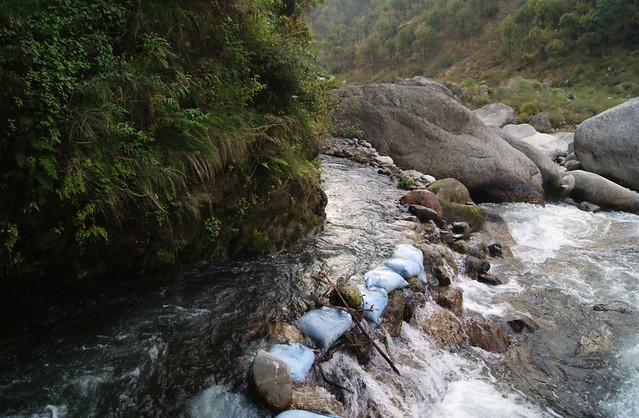 On the other hand, 694 multi-village kuhls and over 2,000 intra-village kuhls in Kangra were sponsored by local groups of irrigators thus making it a local as well as non-local affair depending upon the financial requirements. “Once the kuhl was constructed, it was handed over to the people for maintenance. Everybody wanted water and hence maintained it”, says Kulbhushan Upmanyu, a veteran social activist. Often, the sponsors would nominate a member of a family which contributed the most to the construction of the kuhl and appoint him the kohli.
On the other hand, 694 multi-village kuhls and over 2,000 intra-village kuhls in Kangra were sponsored by local groups of irrigators thus making it a local as well as non-local affair depending upon the financial requirements. “Once the kuhl was constructed, it was handed over to the people for maintenance. Everybody wanted water and hence maintained it”, says Kulbhushan Upmanyu, a veteran social activist. Often, the sponsors would nominate a member of a family which contributed the most to the construction of the kuhl and appoint him the kohli.
How do the kuhls work?
Water was allocated to farmers in turns. In fact, the Riwaz-e-Abpashi, a formal documentation of rights and duties of various villages falling in the command area of a kuhl, is still available with the local revenue offices but most of the dos and don’ts were conveyed orally and were widely followed. The kohli, donning a big turban and carrying a shaft, surveyed the length of a kuhl to check the maintenance requirements before the monsoon since that was the easiest time to stop and divert water. Also, farmers were in need of water the most around that time.
Upmanyu, who has been around since the time village life revolved around the kuhl, recalls how the community bonded then. “The kohli would call upon people and men carrying spades, shovels and ration would head upstream not to be seen for a few days. The party would stay at the head for 4-5 days working in the sun and having long night feasts”, he says. Though not much evidence exists regarding such treats today, a stone at the head of 'Churun kuhl' near Dharamsala mentions that 300 kg of turmeric was used for food preparation during the construction of the kuhl.
Women were not allowed to join in the labour but women-headed households were allocated water without expectation of any returns. Differences cropped up every now and then, sometimes even with the kohli but since everybody’s support was essential to tame the waters, these did not last long.
The degraded kuhls of today
Several trenches crop up sporadically at many places along the road as you go downhill to the centre of Saloh village near the tourist city of Palampur. Once upon a time, these trenches formed one long unhindered kuhl, which met the irrigation and household needs of the village. Over the years, wild growth, new structures along the road and earth overwhelmed it at most places. Villagers get tap water at homes while agriculture is no longer a lucrative livelihood option.
Tarlok Singh awaits people to get their grains milled but the footfall to the flour mill has dwindled over the years. “Earlier, everybody used to grow grains but now not many are interested. There’s no market for the produce here. 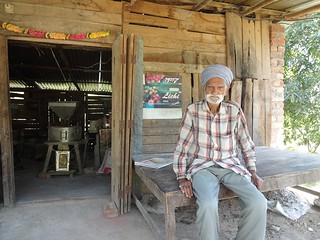 “People prefer buying from PDS ration shops where rice is available for Rs. 10 per kg and wheat flour, for Rs 2. while the same costs Rs. 40 and Rs. 14 respectively in the open market. The government is running under a loss by giving such huge subsidies but more than that, it’s the local farming which has taken the biggest blow. So now, nobody cares about farming and the kuhls. Instead, they throw garbage in it treating it like a drain”, he laments.
“People prefer buying from PDS ration shops where rice is available for Rs. 10 per kg and wheat flour, for Rs 2. while the same costs Rs. 40 and Rs. 14 respectively in the open market. The government is running under a loss by giving such huge subsidies but more than that, it’s the local farming which has taken the biggest blow. So now, nobody cares about farming and the kuhls. Instead, they throw garbage in it treating it like a drain”, he laments.
At Rakkar village near Dharamsala, people get potable water through four ultraviolet water filters installed at community places since the water in the kuhls and in taps is highly polluted. The village used to have traditional kuhls made of mud with stones on the bed. When IPH took over the kuhls, it promised the convenience of water in every home through taps. The kuhls were concretised and an open tank built at top of the mountain to store and supply drinking water. As the monsoon arrived, the local health centre run by an NGO registered around 40 cases of diarrhoea every day. It was found that since animals graze on the hill, their excrement drained into the water tank when it rained.
Earlier, running water came directly from the stream and the bed of the kuhl was full of small stones and various grasses which acted as natural filters. Concretisation of the kuhl took away this protection. The kuhl deteriorated further as people, finding no use for the water, started throwing garbage into the channel. Now the residents, who were promised water supply in their homes, are again walking distances to access potable water but instead of natural kuhls they are getting it from expensive water filters.
Neglected kuhl equals weak society
Upmanyu believes it’s an interplay of various factors which has led to deterioration of communal spirit. “The set up worked successfully until the state and the markets intervened. While new age occupations made income from hill farming negligible in comparison, government departments took over certain kuhls thus further alienating people from its management”, he explains. In response to the state’s interventions, elected kuhl committees were formed to assist kohlis in implementing rules and also to deal with government agencies for grants and negotiation of water rights. But these have turned into another bureaucratic set up.
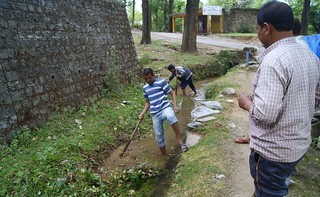 At Kandbari village, only 16 farmers joined the kohli's call for construction and repair work. This is a far cry from around 900 families whose fields fall in the kuhl’s command area. “Instead of a continuous 4-5 day plan, we now only work on Sundays so that government servants are available and students can also chip in. Despite that, there is low attendance and the work done is never satisfactory”, says Joban Ram, who has recently taken the baton of kohli from his father.
At Kandbari village, only 16 farmers joined the kohli's call for construction and repair work. This is a far cry from around 900 families whose fields fall in the kuhl’s command area. “Instead of a continuous 4-5 day plan, we now only work on Sundays so that government servants are available and students can also chip in. Despite that, there is low attendance and the work done is never satisfactory”, says Joban Ram, who has recently taken the baton of kohli from his father.
According to a NSSO 2001 survey, the number of men working in the agriculture sector in rural areas of Himachal Pradesh declined from 77 per cent in 1983 to almost 54 per cent in 1999-2000. One of the reasons is that earlier everybody used to grow their own grains but now the requirement is met through subsidised supply from PDS shops.
The division of landholdings due to expanding families, erratic weather of the hills and damage done by wild animals are some of the other reasons because of which the output from farming is not satisfactory.
The State steps in
Though kings, traders and the British gave donations to construct kuhls since time immemorial, they largely remained non-interfering sponsors. With independence came the socialist welfare state with large public money and the motto to serve people. Aided by funds from USAID and Indo-German projects for irrigation schemes in the 1970s, the Himachal Pradesh government made new kuhls and took over several existing ones. Money for the kuhls also started coming from NABARD, Agriculture Department, MPLAD scheme and recently MGNREGA.
From simple mud channels the kuhls became concrete structures, which were more durable and required lower maintenance but these structures required more resources to repair when broken. It was easy for the villagers to repair the kuhls earlier as mud was available everywhere. For concrete, villagers had to either write to the concerned state agency or the panchayat for the money, which usually took time. “At Nanahar village, a kuhl was concretised through panchayat funds but the quality is so bad that it broke down soon after. Now, it requires RCC repair which is not possible at local level”, Joban Ram says.
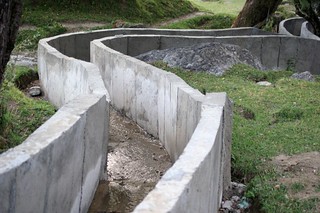 Dhani Ram, 61-year-old kohli of Rakkar village, laments the demise of an easy way to distribute and divert water. “Kuhls were man’s effort to humour water and make it work for him. The water would flow down at its own pace nourishing the surroundings where several types of herbs used to grow. Now with concrete structures they have vanished. You can’t have stop gap arrangements to distribute water. It will follow a set trajectory. In addition, these new structures have such high side walls that it’s impossible for animals to drink during grazing and they have to be taken back home”, he informs.
Dhani Ram, 61-year-old kohli of Rakkar village, laments the demise of an easy way to distribute and divert water. “Kuhls were man’s effort to humour water and make it work for him. The water would flow down at its own pace nourishing the surroundings where several types of herbs used to grow. Now with concrete structures they have vanished. You can’t have stop gap arrangements to distribute water. It will follow a set trajectory. In addition, these new structures have such high side walls that it’s impossible for animals to drink during grazing and they have to be taken back home”, he informs.
However, with dwindling participation of locals in maintaining the kuhls, government aid is also seen as a panacea. At Mjatley village, kohli Ranjit Singh presents his attendance register which shows a 50 per cent drop in number of people volunteering for kuhl’s annual maintenance over the last 10 years. “It’s true that government setup is never efficient. You just need to look at drying handpumps and tubewells. But if there’s no community participation, we have to let the state take over the kuhls”, he asserts.
Kohlis want benefits
With changing socio-economic set up, the status of the kohli has also declined. Even the value of grains he got as a goodwill gesture has gone down thanks to proliferation of cheap grains through PDS. With little to feel proud about, these water masters are now seeking substantial returns for the favours done by them and their ancestors.

Brij Lal of Narvana village is General Secretary of the 'Krishi Sichai Koli Kuhl Sabha', a society of kohlis which has filed a court case against the state government for ignoring them for government jobs. “We have been serving the people ensuring that their water needs are met. If government can take over the kuhls why can’t they recognise our traditional work and give preference to us when hiring people especially in the Department of Water Works?”, Brij Lal asks. The demand may seem in direct conflict with the erstwhile voluntary spirit of the kohli’s work, but it is also a suitable retort to the new system which puts a price tag on everything.
Can diversification save the system?
The immediate consequence related to the communal neglect of kuhls is low water flow and hence changes in crop pattern. Farmers have now taken to transplanted rice variety instead of direct-seeded one. “Direct-seeded paddy is sown early and hence requires assured irrigation before monsoon which was earlier possible through kuhls. The new varieties are planted just before the rains. But it can be a risky proposition if the monsoon fails,” says Ranjit Singh.
Now efforts are being made for crop diversification of a different kind. Japanese International Cooperation Agency (JICA) has been collaborating with Himachal Pradesh’s Agriculture Department to develop profitable forms of agriculture and. Since irrigation is an essential component of farming, attention is also being paid to kuhls. At Kharot village, Rs 3 crore has been sanctioned for the renovation and maintenance of Pathan kuhl. The idea is to motivate farmers to take up cultivation of off-season vegetables, which fetch good prices due to better linkages with markets in Delhi. Higher returns on the income may help rejuvenate the agriculture sector and an indirect benefit of that will be the renewal of the kuhl network.
Dr Sanjeev Kumar Sandal, professor of agronomics at CSK Himachal Pradesh Agriculture University, is leading a research group to calculate the water discharge rate of Kirpal Chand kuhl and its uses for drip irrigation in greenhouses. Initial calculations suggest that the kuhl can fill up a 200 litre tank in 10 minutes and this water is sufficient for drip irrigation in a 100 square metre vegetable greenhouse.
“The state government is already giving a subsidy of 85 per cent on greenhouses which not only insulates the crop against extreme climatic conditions but also provides protection from damage by wild animals. Grain production should be left to plains as they can do it better through flood irrigation. On the other hand, vegetables fetch around Rs 300 per square metre of land as compared to Rs 16 in the case of wheat. We already have good market infrastructure for vegetables. So, this is the only way we can move from subsistence to profitable agriculture”, he says.
But all these propositions will only work when government initiatives involve people. Some inspiration can be drawn from the traditional kuhl set up which gave more importance to the beneficiaries than the patrons.
References
Baker, Mark. Changing Contexts, Steady Flows: Patterns of Institutional Change within the Communal Irrigation Systems (Kuhls) of Kangra Valley, Himachal Pradesh, India. Himalayan Research Bulletin XVI (1-2) 1996.